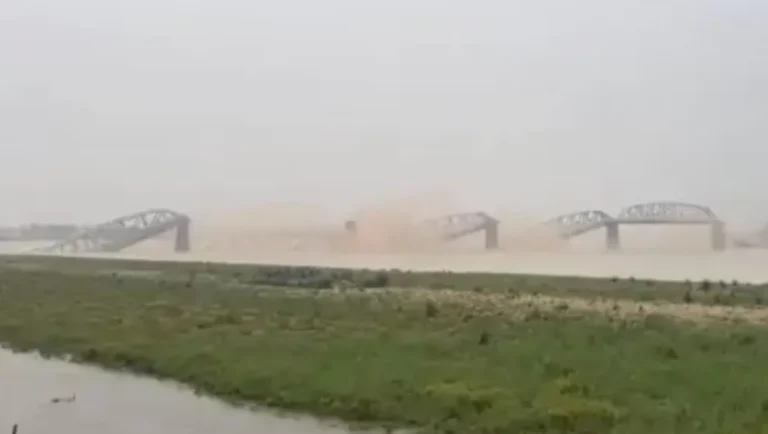Myanmar Earthquake: On March 28, 2025, a massive earthquake off the Richter scale measuring 7.7 shook up central Myanmar, causing widespread devastation with effects felt across Southeast Asia. The tremors, felt as far away as Bangkok, were strong enough to trigger a disastrous collapse of a 30-storey skyscraper under construction in the Thai capital, with a reported 43 workers missing and chaos ensuing in the region. While rescuers try their best to find survivors, authorities will probably focus on assessing the widespread damage caused by the disaster, exposing the vulnerability of urban centers to seismic events coming from hundreds of miles away.
“An earthquake struck among its rugged interior by Myanmar and, according to earthquake monitoring services, the said strike happened at around 11:36 A.M. local time. The earth would start shaking minutes later under Bangkok–the throbbing capital, which is generally more than six hundred miles from ground zero. Office workers poured into the streets, phones clutched tightly in their hands with horrified stares as the skyline trembled around them. Before noon, initial reports of a calamitous structural failure emerged: a commercial site of high-rise construction in Bangkok had pancaked, going floor by floor, into a heap of twisted steel and concrete.”
Collapse in Bangkok: A Race Against Time
Prior to its falls, the skyscraper-in-progress shimmered in the sunlight, even as Thai economics was set on rapid urban development. The structure undergoes elements of dust and terror- a cacophonic crash, the first fallen column, and a surreal demolition sequence, recounted the witness. Onlookers said it was like a movie, said street vendor Somsak Chaiyaporn. “Some seconds it was there, the next second it disappeared. I saw people running, screaming.”
Rescue work began almost immediately, as the emergency crews descended upon the rubble armed with thermal imaging cameras and heavy machinery. Thai Authorities confirmed that 43 construction workers were unaccounted but the exact number trapped beneath the debris remains unknown. “We’re working on it as fast as we can,” said Police Major General Thawatchai Suksri, who oversaw the effort. “Every minute counts. We’re hearing faint cries from below, but intensity of the site is slowing us down.”
An emergency has been declared by Bangkok’s governor as a two-block zone is cordoned off around the collapse zone. The hospitals in the city are put on alert, expected to receive a considerable number of injured. The body of at least one person regarding the incident has been confirmed-a security guard at the site-however, officials are concerned that the death toll may grow significantly as the search continues.

Myanmar Earthquake Heartland Bears the Brunt
An earthquake was the main cause of destruction to Myanmar. Setting apart from the prevailing politics of desolate infrastructures, there seem to be insignificant reports regarding initial assessment of the damage, with the US Geological Survey estimating thousands dead and widespread destruction. Villages lining the fault line are thought to have been completely leveled, leaving slides burying homes in the mountainous areas. Little has been done by the Myanmar junta government regarding a report on the disaster, while local media inform that damage in roads hampered rescue efforts with communication blackouts.
This quake, measuring 7.7 on the Richter scale, is among the strongest to have hit the region for decades. After this quake, a second tremor of 6.4 struck, compounding damage. Aftershocks could persist for several days, posing additional threats to the already weakened structures, seismologists warn. “This was a shallow quake, so it’s more destructive,” Dr. Somsri Kittisak, a geophysicist from Chulalongkorn University, said. “It radiated the energy outwards, striking Bangkok with an unexpected force.”
Regional Ripples and a Call for Preparedness
The disaster has spread waves of shock in Myanmar and Thailand to other Southeast Asian countries and this has sent several ripples around the globe. Further north in Chiang Mai, as much as 400 miles, there were swaying buildings and cracked walls, told residents. Even as far as Ho Chi Minh City, Vietnam has seen office towers emptying in anticipation. It once again raises eyebrows about the adequacies of building codes and earthquakes preparedness in a part of the world normally not considered at risk for large shakes.
But for now, the emphasis is on the human cost. Families of missing laborers congregate in Bangkok around the area of the collapse, clutching pictures and praying for miracles. “My brother was on the 15th floor,” Naree Phan said, her voice wobbling. “He called me just before it happened, said the ground was shaking. Then the line went dead.”
As night falls on March 28, glow floods under floodlights onto the wreckage in Bangkok, while Myanmar‘s rural heartlands lay in darkness. Each tragedy alone reminds that nature’s power is unpredictable; the human effort is very fragile. The death toll is likely to rise as the direct effects are still taking shape, and the region is gearing up for a long, painful recovery.




